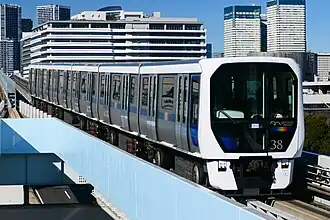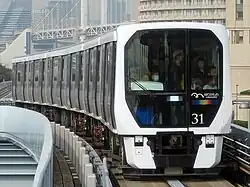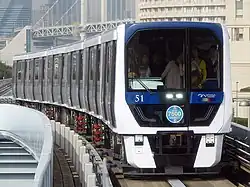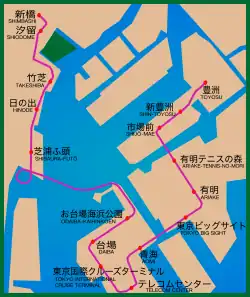Yurikamome
| Yurikamome | |||||||||||||||||||||||||||||||||||||||||||||||||||||||||||||||||||||||||||||||||||||||||||||||||||||||||||||||||||||||||||
|---|---|---|---|---|---|---|---|---|---|---|---|---|---|---|---|---|---|---|---|---|---|---|---|---|---|---|---|---|---|---|---|---|---|---|---|---|---|---|---|---|---|---|---|---|---|---|---|---|---|---|---|---|---|---|---|---|---|---|---|---|---|---|---|---|---|---|---|---|---|---|---|---|---|---|---|---|---|---|---|---|---|---|---|---|---|---|---|---|---|---|---|---|---|---|---|---|---|---|---|---|---|---|---|---|---|---|---|---|---|---|---|---|---|---|---|---|---|---|---|---|---|---|---|
 | |||||||||||||||||||||||||||||||||||||||||||||||||||||||||||||||||||||||||||||||||||||||||||||||||||||||||||||||||||||||||||
 A Yurikamome train in January 2025 | |||||||||||||||||||||||||||||||||||||||||||||||||||||||||||||||||||||||||||||||||||||||||||||||||||||||||||||||||||||||||||
| Overview | |||||||||||||||||||||||||||||||||||||||||||||||||||||||||||||||||||||||||||||||||||||||||||||||||||||||||||||||||||||||||||
| Other name(s) | U | ||||||||||||||||||||||||||||||||||||||||||||||||||||||||||||||||||||||||||||||||||||||||||||||||||||||||||||||||||||||||||
| Native name | 新交通ゆりかもめ | ||||||||||||||||||||||||||||||||||||||||||||||||||||||||||||||||||||||||||||||||||||||||||||||||||||||||||||||||||||||||||
| Owner | Yurikamome, Inc. (direct) Tokyo Rinkai Holdings Company, Ltd. (TRHC; indirect) Tokyo Metropolitan Government (ultimate; largest shareholder in the TRHC)[1] | ||||||||||||||||||||||||||||||||||||||||||||||||||||||||||||||||||||||||||||||||||||||||||||||||||||||||||||||||||||||||||
| Locale | Tokyo, Japan | ||||||||||||||||||||||||||||||||||||||||||||||||||||||||||||||||||||||||||||||||||||||||||||||||||||||||||||||||||||||||||
| Termini | |||||||||||||||||||||||||||||||||||||||||||||||||||||||||||||||||||||||||||||||||||||||||||||||||||||||||||||||||||||||||||
| Stations | 16 | ||||||||||||||||||||||||||||||||||||||||||||||||||||||||||||||||||||||||||||||||||||||||||||||||||||||||||||||||||||||||||
| Website | yurikamome.co.jp | ||||||||||||||||||||||||||||||||||||||||||||||||||||||||||||||||||||||||||||||||||||||||||||||||||||||||||||||||||||||||||
| Service | |||||||||||||||||||||||||||||||||||||||||||||||||||||||||||||||||||||||||||||||||||||||||||||||||||||||||||||||||||||||||||
| Type | Automated guideway transit | ||||||||||||||||||||||||||||||||||||||||||||||||||||||||||||||||||||||||||||||||||||||||||||||||||||||||||||||||||||||||||
| Operator(s) | Yurikamome, Inc. | ||||||||||||||||||||||||||||||||||||||||||||||||||||||||||||||||||||||||||||||||||||||||||||||||||||||||||||||||||||||||||
| Depot(s) | Ariake | ||||||||||||||||||||||||||||||||||||||||||||||||||||||||||||||||||||||||||||||||||||||||||||||||||||||||||||||||||||||||||
| Rolling stock | 7300 series, 7500 series (6-carriage train) | ||||||||||||||||||||||||||||||||||||||||||||||||||||||||||||||||||||||||||||||||||||||||||||||||||||||||||||||||||||||||||
| Daily ridership | 125,000/day (FY 2023)[2] | ||||||||||||||||||||||||||||||||||||||||||||||||||||||||||||||||||||||||||||||||||||||||||||||||||||||||||||||||||||||||||
| History | |||||||||||||||||||||||||||||||||||||||||||||||||||||||||||||||||||||||||||||||||||||||||||||||||||||||||||||||||||||||||||
| Opened | 1 November 1995[2] | ||||||||||||||||||||||||||||||||||||||||||||||||||||||||||||||||||||||||||||||||||||||||||||||||||||||||||||||||||||||||||
| Technical | |||||||||||||||||||||||||||||||||||||||||||||||||||||||||||||||||||||||||||||||||||||||||||||||||||||||||||||||||||||||||||
| Line length | 14.7 km (9.1 mi) | ||||||||||||||||||||||||||||||||||||||||||||||||||||||||||||||||||||||||||||||||||||||||||||||||||||||||||||||||||||||||||
| Number of tracks | Double-track | ||||||||||||||||||||||||||||||||||||||||||||||||||||||||||||||||||||||||||||||||||||||||||||||||||||||||||||||||||||||||||
| Electrification | 600 V 50 Hz 3-phase AC Third rail | ||||||||||||||||||||||||||||||||||||||||||||||||||||||||||||||||||||||||||||||||||||||||||||||||||||||||||||||||||||||||||
| Operating speed | 60 km/h (37 mph) | ||||||||||||||||||||||||||||||||||||||||||||||||||||||||||||||||||||||||||||||||||||||||||||||||||||||||||||||||||||||||||
| |||||||||||||||||||||||||||||||||||||||||||||||||||||||||||||||||||||||||||||||||||||||||||||||||||||||||||||||||||||||||||
New Transit Yurikamome (新交通ゆりかもめ, Shinkōtsū Yurikamome), formerly the Tokyo Waterfront New Transit Waterfront Line (東京臨海新交通臨海線, Tōkyō Rinkai Shinkōtsū Rinkai-sen), is an automated guideway transit service operated by Yurikamome, Inc. in Tokyo, Japan. It connects Shimbashi to Toyosu, via the artificial island of Odaiba, a market in which it competes with the Rinkai Line.
The line is named after the black-headed gull (yurikamome in Japanese),[3] a common denizen of Tokyo Bay and the official metropolitan bird.[4]
History
The line was one of the two lines constructed to transport people into the Rinkai subcenter, the other line being the Rinkai Line. The Rinkai subcenter was planned to be the seventh subcenter of Tokyo as far as back in 1979. In April 1989, the subcenter was planned to have 60,000 residents and 110,000 workers by the start of the 21st century. This plan was forced to be revised upon the collapse of the asset price bubble. The opening of the Yurikamome and the Rinkai line in 1995 and 1996 was planned to be ready by the start of the World City Expo in 1996. However, the expo was cancelled by Yukio Aoshima in April 1995.[5] On 1 November 1995, the section between Shimbashi and Ariake opened, using a temporary Shimbashi station. In the first few months of operation, ridership hovered around 27,000 passengers per day.[6]
In 1996, the Tokyo Metropolitan Government re-zoned Odaiba from pure business and residential to also permit entertainment zones. The island provided Tokyo with a strip of livable seaside, and within one year, ridership doubled to 60,000. As more and more restaurants, shopping malls, exhibition centers and museums opened, traffic continued to grow.[6] On 22 March 2001, the current Shimbashi station opened and the temporary station closed. Shiodome Station opened on 2 November 2002. [7] On 27 March 2006, the section between Ariake and Toyosu opened and stations adopted letter and number codes based on Tokyo Metro.[8]
On 16 March 2019, two stations were renamed: Fune-no-kagakukan became Tokyo International Cruise Terminal, and Kokusai-tenjijō-seimon became Tokyo Big Sight.[9]
There was an unrealized plan to extend the line to Kachidoki Station from at least 2000, although this plan was not in the 2016 list of considered transit routes.[10][11]
Infrastructure
The Yurikamome is Tokyo's first fully automated and driverless transit system, controlled entirely by computers with no drivers on board. However, the line is not the first fully driverless transit line in Japan, as the Nagoya Municipal Subway tested the system in 1960, the driverless technology was used during the Expo '70, and Kobe's Port Liner opened in 1981 before the Yurikamome.[12][13] The trains run with rubber-tired wheels on elevated concrete track guided by the side walls.[12]
Rolling stock
The line uses Mitsubishi Heavy Industries rubber-tired "Crystal Mover" technology.[14] As of 8 April 2021, the following train types are used on the line, all formed as six-car sets.[15]
7300 series

As of 2021, eighteen 7300 series sets (31 to 48) are in service, formed as six-car sets as follows.[16]
| Car No. | 1 | 2 | 3 | 4 | 6 | 7 |
|---|---|---|---|---|---|---|
| Designation | Mc1 | M2 | M3 | M4 | M5 | Mc6 |
| Numbering | 73x1 | 73x2 | 73x3 | 73x4 | 73x5 | 73x6 |
("xx" stands for the unit number.)
7500 series

As of 11 August 2024, eight 7500 series sets (51 to 58) are in service, formed as six-car sets as below.[15] In November 2020, delivery of the eight six-car sets was completed.[17]
| Car No. | 1 | 2 | 3 | 4 | 6 | 7 |
|---|---|---|---|---|---|---|
| Designation | Mc1 | M2 | M3 | M4 | M5 | Mc6 |
| Numbering | 75x1 | 75x2 | 75x3 | 75x4 | 75x5 | 75x6 |
("xx" stands for the unit number.)
Stations
Since 2006, all the stations use the recorded voices of different voice actors for their Japanese-language announcements.[18] The letter "U" is used as the symbol for station numbers rather than "Y" for Yurikamome as this letter is already used as the acronym for the Tokyo Metro Yurakucho Line.
Ridership

Ridership on the line peaked at over 200,000 daily boardings in 2000,[19] but declined substantially by 2004 as the Rinkai Line, which opened a year after the Yurikamome Line, expanded into more of the waterfront area and offered lower fares. Between 2004 and 2006, four new stations were added, which raised ridership slightly. As of 2023, daily ridership totals are roughly 97% of pre-pandemic levels with patronage shifting to the eastern end of the line.
| Station | 2000 | 2004 | 2006 | 2019[20] | 2022[21] | 2023[22] | |
|---|---|---|---|---|---|---|---|
| U-01 | Shimbashi | 94,217 | 63,791 | 58,824 | 63,123 | 44,343 | 56,027 |
| U-02 | Shiodome | -- | 7,500 | 7,805 | 8,755 | 5,650 | 7,463 |
| U-03 | Takeshiba | 4,681 | 9,301 | 4,701 | 4,508 | 4,126 | 4,833 |
| U-04 | Hinode | 1,675 | 2,043 | 2,271 | 2,322 | 2,015 | 2,404 |
| U-05 | Shibaura-futō | 6,970 | 5,875 | 5,166 | 5,090 | 4,313 | 4,907 |
| U-06 | Odaiba-kaihinkōen | 19,406 | 15,859 | 14,497 | 16,899 | 11,171 | 13,195 |
| U-07 | Daiba | 28,838 | 22,866 | 21,682 | 21,421 | 14,135 | 20,606 |
| U-08 | Tokyo International Cruise Terminal (former name: Fune-no-kagakukan) |
2,734 | 3,506 | 3,579 | 3,191 | 2,300 | 2,963 |
| U-09 | Telecom Center | 13,561 | 11,233 | 10,649 | 12,140 | 8,118 | 8,505 |
| U-10 | Aomi | 11,529 | 7,152 | 7,153 | 11,884 | 1,707 | 1,483 |
| U-11 | Tokyo Big Sight (former name: Kokusai-tenjijō-seimon) |
21,420 | 13,885 | 16,312 | 16,690 | 13,876 | 19,352 |
| U-12 | Ariake | 3,531 | 2,509 | 3,743 | 5,818 | 7,669 | 9,242 |
| U-13 | Ariake-Tennis-no-mori | -- | -- | 1,185 | 5,022 | 6,351 | 8,148 |
| U-14 | Shijō-mae | -- | -- | 76 | 11,393 | 11,285 | 13,997 |
| U-15 | Shin-toyosu | -- | -- | 893 | 6,796 | 7,144 | 11,256 |
| U-16 | Toyosu | -- | -- | 9,494 | 28,916 | 27,545 | 33,957 |
| Totals | 208,562 | 165,520 | 168,030 | 223,968 | 171,748 | 218,338 | |
See also
References
- ^ "Unmanned Tokyo transit line remains shut down". The Japan Times. 16 April 2006. Retrieved 25 May 2020.
- ^ a b "会社概要". YURIKAMOME Inc. Retrieved 18 April 2025.
- ^ Developing Metros. Transport Press. 1996. p. 6. ISSN 0268-5590. OCLC 12264501.
- ^ "Tokyo's Symbols". Tokyo Metropolitan Government. Archived from the original on 1 April 2023. Retrieved 25 May 2020.
- ^ "パレットタウンも消滅へ お台場どうなる? 再開発&新地下鉄で挫折の歴史は報われるか - (2)". 乗りものニュース (in Japanese). 16 August 2021. Retrieved 1 August 2025.
- ^ a b Iwata, Kazuaki (June 1998). "Tokyo's New Waterfront Transit System" (PDF). Japan Rail and Transport Review.
- ^ "鉄道発祥の地「汐留」に、新しい街と新しい駅-都営地下鉄大江戸線、新交通ゆりかもめ「汐留駅」11月2日に開業-" [A new town and a new station in Shiodome, the birthplace of railways: Toei Oedo Line, New Transit Yurikamome “Shiodome Station” Opens November 2nd]. kotsu.metro.tokyo.jp. 12 July 2002. Archived from the original on 15 October 2002. Retrieved 7 August 2022.
- ^ Terada, Hirokazu (19 January 2013). データブック日本の私鉄 [Databook: Japan's Private Railways]. Japan: Neko Publishing. pp. 216–220. ISBN 978-4-7770-1336-4.
- ^ "船の科学館駅及び国際展示場正門駅の駅名改称日が決まりました!" [The date of renaming the Fune-no-Kagakukan Station and the International Exhibition Center Main Gate Station has been decided!] (PDF). yurikamome.co.jp (in Japanese). 15 January 2019. Archived from the original (PDF) on 3 March 2019. Retrieved 7 August 2022.
- ^ "「永遠に豊洲で止まっていただきたい」ゆりかもめ延伸計画が非業の末路に至った事情". ダイヤモンド・オンライン (in Japanese). 30 June 2023. Retrieved 1 August 2025.
- ^ "ゆりかもめ、豊洲の先どこへ行く? 計画は人口増で白紙 東京湾岸エリアの状況背後に - (3)". 乗りものニュース (in Japanese). 22 October 2019. Retrieved 1 August 2025.
- ^ a b "Rubber-Tired Trains in City Transport". The Wall Street Journal. Dow Jones & Company, Inc. 27 September 2019. Retrieved 25 May 2020.
- ^ "鉄道の自動化、運転士より先に「車掌」が消える". 東洋経済オンライン (in Japanese). 13 May 2019. Retrieved 1 August 2025.
- ^ "Automated People Mover". Mitsubishi Heavy Industries Ltd. 2015. Archived from the original on 9 March 2017. Retrieved 29 September 2015.
- ^ a b 私鉄車両編成表 2016 [Private Railway Rolling Stock Formations - 2016] (in Japanese). Japan: Kotsu Shimbunsha. 25 July 2016. p. 79. ISBN 978-4-330-70116-5.
- ^ 私鉄車両編成表2021 [Private Railway Vehicle Organization Table 2021] (in Japanese). Japan: Kotsu Shimbunsha. 16 July 2021. p. 85. ISBN 9784330032214.
- ^ "Light metro cars bring a fresh breeze to Tokyo's waterfront". Railway Gazette. 13 November 2020. Archived from the original on 28 July 2021. Retrieved 14 November 2020.
- ^ "Voice guide device". yurikamome.co.jp (in Japanese). Archived from the original on 16 February 2007.
- ^ "東京臨海新交通 ゆりかもめ メディアロッカー" [Tokyo Rinkai New Transit Yurikamome Media Locker] (PDF). Field Media Network. Fmn-inc.co.jp. Archived from the original (PDF) on 3 November 2006. Retrieved 8 August 2011.
- ^ "移動等円滑化取組報告書(鉄道駅)(FY2019)" [Report on efforts to facilitate smooth travel (Railway stations) (2022)] (PDF) (in Japanese). 2019. Archived from the original (PDF) on 3 August 2023. Retrieved 6 January 2025.
- ^ "移動等円滑化取組報告書(鉄道駅)(FY2022)" [Report on efforts to facilitate smooth travel (Railway stations)] (PDF) (in Japanese). 2022. Archived from the original (PDF) on 1 April 2024. Retrieved 5 January 2025.
- ^ "移動等円滑化取組報告書(鉄道駅)" [Report on efforts to facilitate transportation, etc. (railway stations)] (PDF) (in Japanese). 2023. Archived from the original (PDF) on 1 August 2024. Retrieved 6 January 2025.